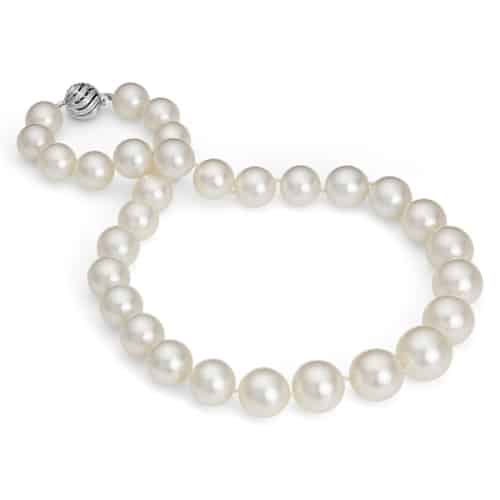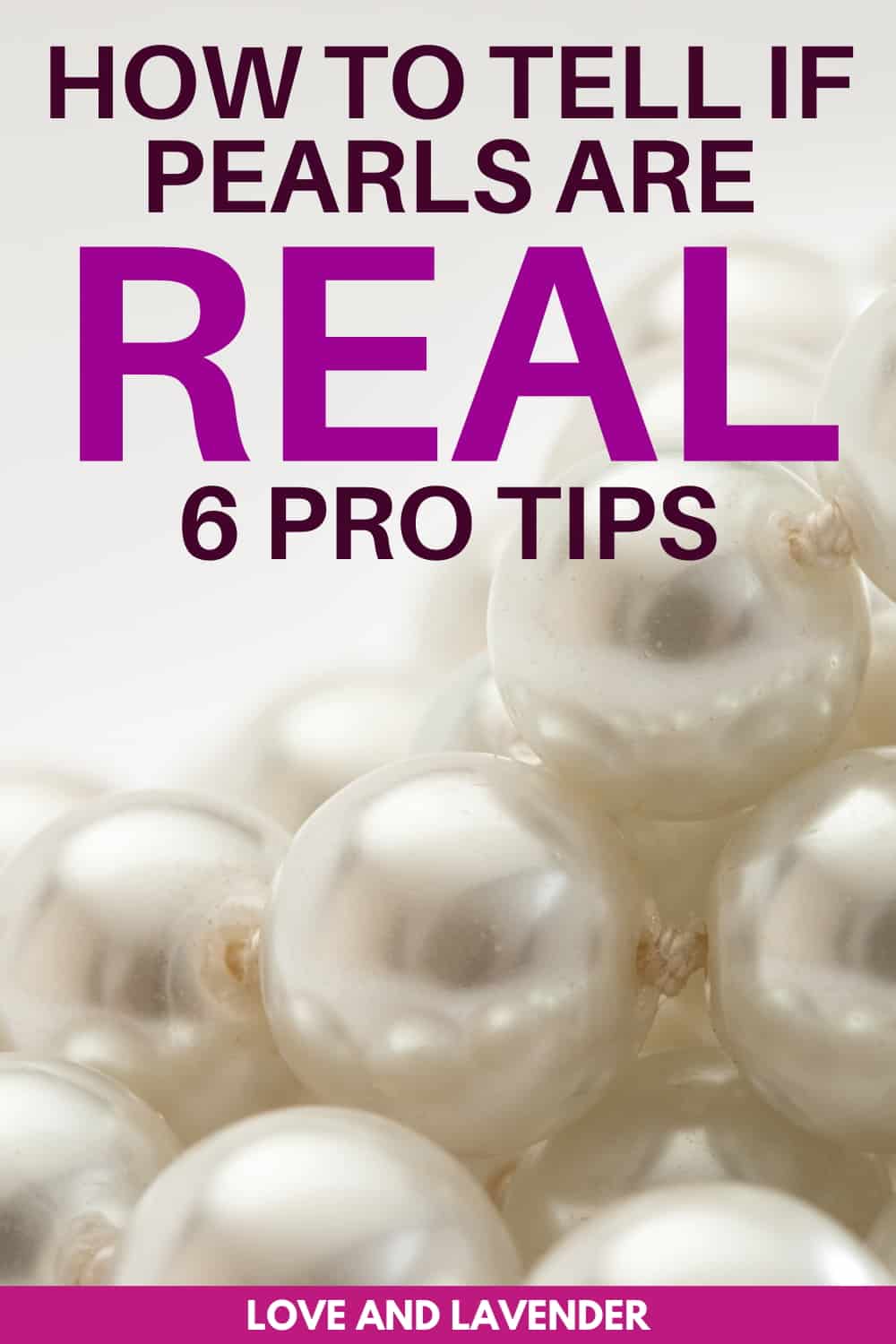How to Know if You Have Real Pearls
Pearls are the dowager queens of the fine jewelry world. Their soft, breathtaking luster is as at home in a sunlit manor garden party as it is in the smoky shadows of your favorite speakeasy.
Favored by fashionistas throughout history from Grace Kelly and Coco Chanel through to Scarlett Johansson and Katy Perry, pearls bring a timeless elegance to both vintage-inspired and gimmicky styles.
However, their universal appeal and increasing value has led to an insurgence of fakes in the jewelry market. It'south of import to know what to look for in your pearl jewelry to brand sure yous're getting the real deal. There are plenty of fakes out there, but we have some quick and easy tricks to assist you make up one's mind if that shiny strand is the real deal.
- What Counts As a "Real" Pearl?
- How Can I Tell If a Pearl is Real?
- Tin can I Tell If a Pearl is Natural or Cultured?
- How Practise I Gauge the Quality of Real Pearls?
- A Annotation On Costume Pearls
What Counts Equally a "Existent" Pearl?
Pearls are what'south known as an organic gemstone, meaning they come from a living affair(other examples of organic gemstones are amber and jet, both of which start their journey in trees).
Broadly speaking, real pearls fall under three categories:
- Cultured freshwater pearls (pearls that have been farmed in bodies of fresh h2o)
- Cultured saltwater pearls (pearls that have been farmed in designated areas of the ocean)
- Natural pearls (that is, "wild" pearls that formed without any human intervention at all)
Though the procedure of growth and the species of oyster can vary from one type of pearl to another, their mineral composition is essentially the aforementioned. This is what differentiates real pearls from imitations.
How Tin can I Tell If a Pearl is Real?
Existent pearls emit an internal glow that no imitation can match. Just if you haven't seen many pearls, that special glow may not be obvious to you lot. Until yous've seen enough pearls side by side to develop the center for it, there's a few things you can await for.
Await for knotting
Because pearls tin be quite delicate, most pearl necklaces will exist strung with tiny knots in between each one. This keeps them from bumping and rubbing confronting each other and wearing downward.
Pearl knotting is a difficult and meticulous skill, and most jewelers wouldn't be willing to invest the time to knot imitation pearl strands. While this tin be a good indication, information technology isn't definitive; not all existent pearl strands come up knotted and sometimes imitation ones will be to make them look more than like existent pearls.
Examine the drill pigsty
While yous're looking at the knots, have a closer look at the hole that'south drilled through each pearl. The hole of an imitation pearl will be large and uneven, and you might see places where the blanket is commencement to pare abroad from the dewdrop — this is peculiarly prominent in older vintage pieces. If you can manage to catch a glimpse inside the pigsty, you'll oftentimes find that the color within the dewdrop doesn't quite match the coating on the exterior.
A existent pearl, by contrast, will have a clean, even hole running through the center. You might come across slight traces of powder where it's been rubbed by the string. The hole volition as well be very narrow; wholesale pearls are usually sold by weight, and drilling the smallest hole possible means more than weight retention (and more than turn a profit).
Examine the surface
While the beginning ii tests only apply to pearl necklaces, this one can exist done with whatever kind of pearl jewelry.
Similar most things in nature, pearls do not grow perfectly uniformly. Existent pearls will have infinitesimal surface irregularities such as bumps and dimples. While these features are less perceptible in very high quality pearls, all will have some sort of defining characteristic if you look very closely. Fake pearls, on the other hand, volition be consistent and smooth all the way around.

Roll it around
This test, unfortunately, just works with loose pearls. As nosotros saw to a higher place, virtually real pearls are not supermodel material. They have irregularities and inconsistencies, including in their shape. If you try to roll information technology in a straight line, chances are it will wobblea little and tilt off course. An faux pearl will be perfectly round and will gyre evenly.
Note that this test is a little trickier with very high-quality pearls. This is actually something gem graders practice when evaluating wholesale pearls. Circular pearls are more than valuable than off-round ones, and perfectly spherical ones that curl in a direct line are the most desirable of all.
Taste it… sort of
This oft-cited pearl test is one of those former wives' tales that really works. Take the pearl and rub information technology (gently!) confronting the surface of your front molar. Your teeth are quite sensitive and tin pick upwardly minute surface variations. A 18-carat pearl will have a crude, sandy quality to it while a false volition feel polish and plasticky.
Other tips and tricks
Other indications include temperature and weight — real pearls have a substantial heft to them compared to fakes, and will feel absurd to the touch — likewise as price and provenance.
The price of existent pearl jewelry reflects its value, and any new pearl jewelry from a reputable retailer should come with some sort of grading certificate or documentation. False pearls are ordinarily sold for very picayune.
The exception? Costume pearls from big proper name luxury brands, such equally Chanel or Dior. These synthetic pearls can sell for big money, whether new or vintage. However, these items should always be sold with full honesty and transparency. If you're not sure, see if you tin view the item in person and exercise some of these tests above.
Tin can I Tell If a Pearl is Natural or Cultured?
Information technology is very difficult to see the deviation between a natural and cultured pearl with the naked eye. The vast, vast majority of pearls sold on the jewelry market these days are cultured, and they are accepted as the standard for "real" pearls. Nigh natural pearls that come are exquisite vintage pieces that sell for large ticket prices.
If you think your vintage pearl strand might be made of natural pearls, you can look at them confronting a very strong calorie-free. A cultured saltwater pearl will glow darker in the eye where the base of the pearl was implanted. Natural pearls, by dissimilarity, will glow more than uniformly.
It can be almost incommunicable to tell the difference between natural and freshwater pearls, however, because their formation procedure is so similar.
Unfortunately, in that location'southward a lot of misinformation about "natural" pearls and some jewelry retailers unknowingly use the term incorrectly. The only way to know for sure if your pearl is of natural origin is to take it to a gemologist, where they can 10-ray it and examine the patterns of growth inside the pearl.
How Do I Gauge the Quality of Existent Pearls?
Pearls are judged on seven consistent quality factors:
- Luster
- Shape
- Nacre Quality
- Color
- Surface Quality
- Matching (or craftsmanship)
- Size
The highest quality pearls will be perfectly round, bright, shine, and consistent, with abrupt loftier-contrast reflections.
Depending on these value factors, yous tin detect real pearls at very affordable entry-level prices going up to tens or hundreds of thousands of dollars for bright, perfectly matched designer south body of water pearls.
Pearls are timelessly classic and always in need, and with more and more innovative young jewelers making waves throughout the manufacture in that location are unique pieces to suit every style.
A Annotation On Costume Pearls
The vintage fashion industry boasts a proud lineage of faux pearl strands. Mademoiselle Coco Chanel was famous for barreling through all sorts of fashion "rules" of her solar day – one of the things she was notorious for was wearing both existent and imitation pearls at the aforementioned fourth dimension(!).
One of the unfortunate truths near real pearls is that they are quite frail and are hands damaged by the harsh chemicals found in things similar detergent, hair spray, and perfume.
If y'all're someone who uses these products a lot, a strand of vintage costume pearls might be the right pick for yous. Alternatively, yous could accept costume pearl jewelry for day-to-24-hour interval wear and keep your real pearls for special occasions.
Or, like, Mlle. Chanel, y'all could throw them all on at the same time. Make your own rules.
Practically Pearl-Fect
Evaluating pearl jewelry takes a conscientious center, but with some patience and attending you tin can go a pretty good thought of whether or not your jewelry is made from real pearls.
Look at the craftsmanship of the slice, the natural surface markings and characteristics, and the quintessential, distinctive pearlescent glow that we call luster. Use all your senses to get a feel for its weight, reflective qualities, and the mode it rests against your skin.
Null quite compares to real pearl jewelry, merely it'south worth remembering that imitation pearls have their place non only every bit an affordable like shooting fish in a barrel-care alternative, but in our cultural history. So apply these tricks and tips when shopping for natural, cultured, or false pearls to brand certain you're making informed choices and proudly wearing the style that you lot love.
Did you find this postal service useful? And then save THIS PIN below to your Jewelry lath for subsequently!

juarezactemend1952.blogspot.com
Source: https://www.loveandlavender.com/how-to-tell-if-pearls-are-real/
0 Response to "How to Know if You Have Real Pearls"
Enviar um comentário